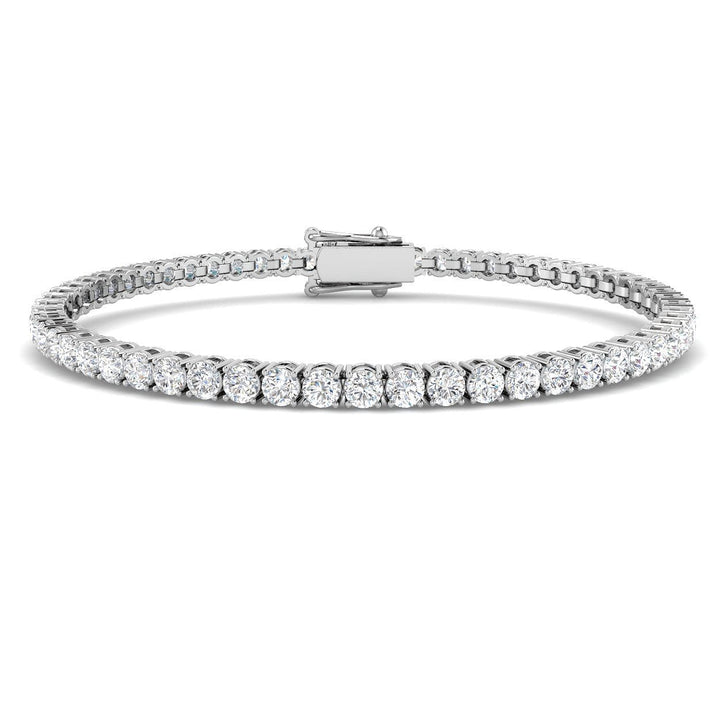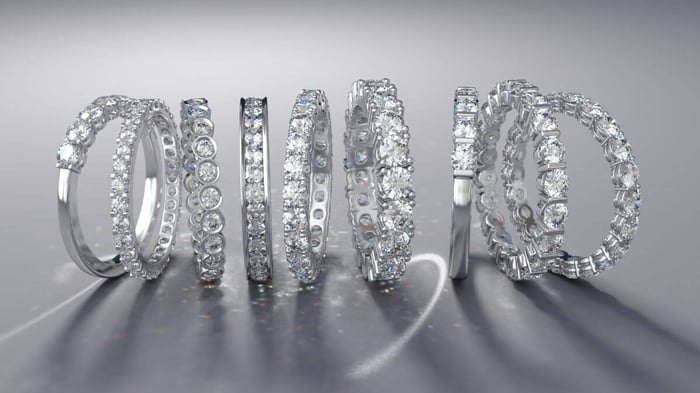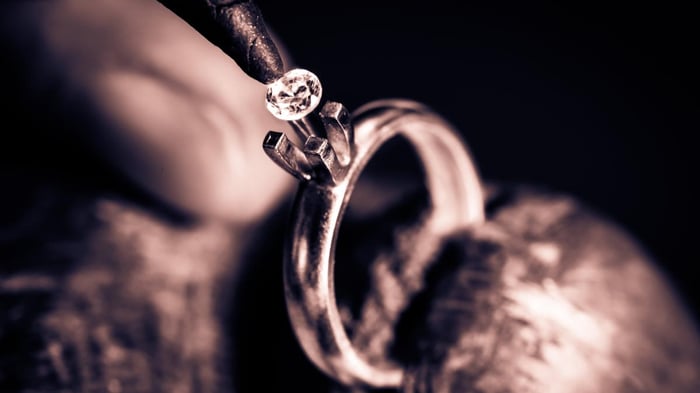Four-Prong Diamond Settings Versus Six-Prong Diamond Settings. What's RIght About Prong And Claw Settings?
A diamond’s appearance is almost entirely due to the way it is cut, polished and mounted onto its precious metal setting. Prong and claw settings are words you will often see in connection with the way that diamonds are set into a piece of diamond jewellery.
But the type of setting is, for most buyers of diamond jewellery, almost the last thing they think of if they give the matter any thought at all.
Recently we published an article on this blog about the different ways that diamonds are mounted on the jewellery that we sell.
In this article, we will delve into one particular setting, type the prong or claw setting.
Colgante de cruz de diamantes con montura de garra clásica de 0,25 quilates en oro blanco de 18 quilates

€700,95
Sencillo, elegante y clásico. Este colgante de cruz de diamantes de un cuarto de quilate es una pieza atemporal que combinará con cualquier atuendo y joyería que ya posea; renovando todo tu guardarropa. Estamos orgullosos de ofrecer un collar colgante… read more
The prong or claw is the most popular setting type because it allows precious stones to be seen easily; very little of the gem is concealed. Simultaneously, the claws of the setting enable a gemstone to give off its best possible sparkle because the facets of the stone are almost totally exposed to catch and reflect light.
Coincidentally, and very fortunately for jewellers, the claw setting is also a very secure way to hold a stone in place on a piece of fine jewellery.
What Is A Prong (Or Claw)?
A prong is a small piece of metal that is shaped around the profile of a precious stone. Several are used to hold the stone securely in place.
Prongs have several shapes; they may be rounded, flat, v-shaped or round. The v-shaped prong is most commonly used with diamond shapes with sharp edges such as princess, pear or marquise.
Prongs – It’s A Game Of Numbers!
It’d be easy to think that when it came to prongs on jewellery that the designer comes up with a particular number of prongs because it looks pretty. The craftsmen solder them to the ring, and that’s the job, done.
But no, different types of jewellery, different shapes and even size play a role in how many prongs are used to hold a diamond in place. Most designers use either four or six prongs in their work as these give the best compromise in terms of beauty and security. Still, there are good reasons to choose one over the other, depending on the circumstances.
|
Six Prongs |
Four Prongs |
|
Cover more of the diamond |
Reveal more of the diamond |
|
Makes a diamond look smaller |
Emphasises the size of a diamond |
|
Softens the profile ofdiamond |
Emphasises the edges and angles of the diamond |
|
More difficult to clean |
Easier to clean |
|
More secure than 4 prongs |
Less secure than 6 prongs |
|
Makes a diamond look more round |
Makes a diamond look more square |
|
Makes a diamond look less brilliant |
Greater brilliance and sparkle |
Because the metal of the prong covers the diamond light cannot pass through it. This means a four-pronged setting will tend to allow the diamond to sparkle better than a six-prong setting. If you want to maximise brilliance and sparkle, choose a four-prong design over a six-prong alternative.
If you want your diamonds to look larger then choose a four-prong setting. That's because any metal covering the diamond tends to make it look smaller, the four-prong setting, which covers less of the diamond’s surface, will usually cause the diamond to look larger than the same size stone in a six-prong setting.
As a general rule, if you buy diamond jewellery where the central stone is less than 1 carat in size, a four-prong setting is the best choice. It will make the stone look larger and more brilliant, despite its relatively small size.
A four-prong setting can cause a diamond to look more square than round as the prongs create a visual corner to the stone. A six-prong setting breaks up the circumference of the diamond, making it look more rounded. For this reason, if buying a square or rectangular shaped diamond, then a four-prong setting is the best choice. On the other hand, a round diamond with six prongs will always look more rounded.
Safety and Cleaning Of Four Or Six Prong Rings
The fewer prongs securing the diamonds in your jewellery, the easier it will be to clean them. There’s simply fewer nooks and crannies able to harbour muck and grime. That makes four-prong settings a clear winner. However, convenience comes with a downside. There is no doubt that a well-made six-prong setting will always be more secure than a similar quality four-prong setting. That said, in real life and most situations, a four-prong setting is entirely adequate. However, you should make sure that you have insurance against the loss of precious stones, whatever fine jewellery you own, or the type of setting!
Over time, the metal of the prongs can become worn or distorted, reducing the strength and security of the setting. Every year or so, take your jewellery to be inspected and, if necessary, repaired before something terrible happens!
If necessary, the jewellery will remove worn or damaged prongs and replace them with new secure ones. If the wear on the prongs is not too severe, more metal can be added to the ends of the prongs, making them fit for service for a long time to come.
Which Is Better? Four Or Six Prongs?
In the end, the answer is ‘It depends’. From the perspective of appearance, a four-prong setting will usually look better. The diamond will have more sparkle, will look larger and be easier to keep clean. On the other hand,a six-prong setting will be longer-lasting, more secure.
If the diamond is less than 1 carat in size, the answer is possibly easier to define. On a small diamond, the prongs will inevitably be more secure. The prongs will cover a greater proportion of the diamond than on a larger diamond. So, a four-prong setting is probably the best choice.
Brazalete de tenis de diamantes de 5,00 ct con punta redonda G/SI en oro blanco de 18 k

€7.181,95
Un brazalete de tenis clásico en oro blanco brillante de 18k con cinco quilates de diamantes de grado G/SI le da un aspecto divertido y fresco. Una pieza sofisticada hecha a mano por nuestros artesanos del Reino Unido traerá sonrisas… read more
If you choose a larger diamond and your heart is set on a four-prong design, consider platinum as the precious metal. Platinum is harder and more durable than gold and so less susceptible to damage and better secure your precious diamonds.
As you can see, when you look at our collections of diamonds, we tend to follow our own advice when it comes to the number of prongs used on our prong/claw set diamond jewellery. Please take a moment to browse our collections of British designed fine diamond jewellery. We’re confident that what you see will inspire you!




